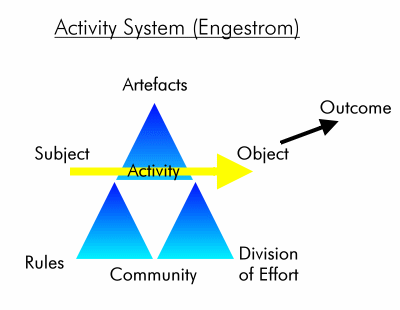 Visualizing the activity theory is the best way to draw similar views for 2 courses to compare them. I take Engestrom triangle as the source for my analysis, and build New Interactive Environment course and PLENK on this one.
Visualizing the activity theory is the best way to draw similar views for 2 courses to compare them. I take Engestrom triangle as the source for my analysis, and build New Interactive Environment course and PLENK on this one.PLENK2010
 |
| PLENK2010 visualization according Activity theory |
Subjects: Participants
Object: According the homepage of PLENK2010 The purpose of this course will be to clarify and substantiate, from the context of this new research, the concepts of personal learning environments and networks. Course facilitators and participants will analyze the research literature and evaluate it against their own experience with the intent of developing a comprehensive understanding of personal learning environments and networks.
Rules: Signing up, course activities, privacy policy
Instruments: live sessions, course content, wiki, personal learning environment, daily newsletter, RSS feed, SM tools - Twitter, blogs, Moodle, Delicious, other possible SM tools according the flow and need in the course.
Community: guest speakers, students, teachers,
Effort: students,
New interactive environments
 |
| New Interactive Environments visualized according Activity theory |
Subjects are students who participate in this course.
Object is the curriculum of New Interactive Environment. It says: Participants acquire conceptual knowledge and procedural skills on how to analyse, represent, and (re-)instrumentalise human activities and activity systems with networked tools and services.
Rules are the tasks, and deadlines that are listed by the teachers. But also the means how to fill the tasks are aprt of rules here - for example that tasks has to be done for certain deadline by certain ways - in blogs.
Instruments (artefacts) - there are several instrumenrs used in this course. Several are software tools that students use to do their homework and fill tasks - both online and offline tools. One of the most important instrument is the blog where students show their tasks and the course blog where new tasks are being published.
NIE wiki
NIE wiki
Community in this NIE course can be taken as small group of people who participate in this course, but I would also consider it in a broader way, as community that affects the learned subject is much bigger. I would also take the whole IMKE department and Tallinn University in this community. As tasks are published through blogs then anonymous blogosphere is also part of the community in here.
Effort - students are the ones who fill the tasks in here. But we should't forget teachers who come up with tasks as well. Students couldn't do their tasks if someone wouldn't list them.
Comparison of NIE and PLENK2010 courses according Activity theory
Both of the courses are online courses, it makes them quite similar from Activity theory perspective as well.
Both courses use several social media and digital media tools as part of the course and tasks are being shown by menas of these tools. Students are subjects and community in both courses and teachers are the ones who give tasks
Both courses are also similar by overall way of course building, not all tasks or deadlines are given before the course, but considering the flow and ways how course goes new tasks and deadlines are given.
Comparison of NIE and PLENK2010 courses according Activity theory
Both of the courses are online courses, it makes them quite similar from Activity theory perspective as well.
Both courses use several social media and digital media tools as part of the course and tasks are being shown by menas of these tools. Students are subjects and community in both courses and teachers are the ones who give tasks
Both courses are also similar by overall way of course building, not all tasks or deadlines are given before the course, but considering the flow and ways how course goes new tasks and deadlines are given.
As I understand the students in PLENK2010 course are not necessarily students from thabasca University and the University of Prince Edward Island but can be anyone who are interested, this is the main difference with NIE as students in NIE are Tallinn University students who chose to take the course and get graded for what they do in NIE.
In PLENK2010 there are also guest lecturers and everybody are expected to listen to them.
Also tools like Twitter and blogsa re expected to be used not only to fill the tasks, but to talk about the thoughts that participatns come up with and tag them with #PLENK2010
Students/participants are important in both courses, they are subjects, they are the ones who use all the tools, they are the ones who are "labor" for the course, and at the same time influence the course overall doings through communication and thoughts.
Students/participants are important in both courses, they are subjects, they are the ones who use all the tools, they are the ones who are "labor" for the course, and at the same time influence the course overall doings through communication and thoughts.

